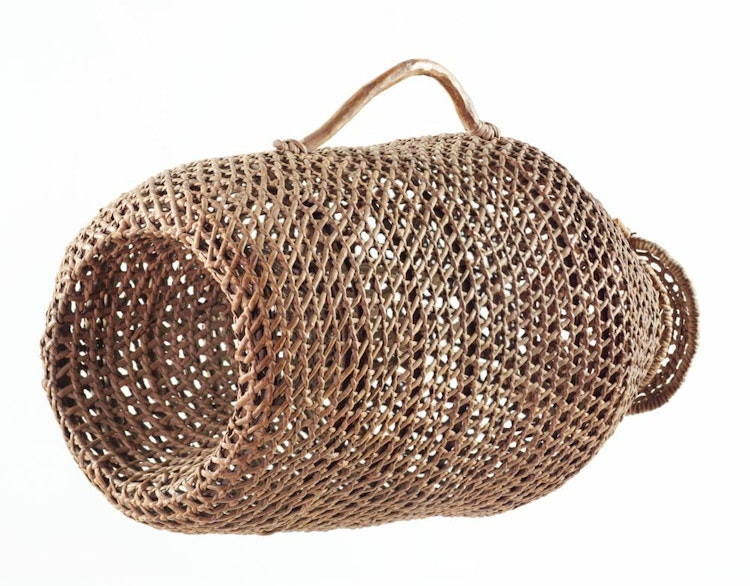

Museum of New Zealand Te Papa Tongarewa
The Dowse Art Museum
Matthew McIntyre Wilson and Sara McIntyre
In the following interview artist and weaver Matthew McIntyre Wilson talks with Te Papa Tongarewa curator Isaac Te Awa about how he came to work with the museum's collections and the people of Whanganui to revitalise the weaving of customary hīnaki eel traps.
*List with definitions of Māori terms at the end of the article.
“Ko au te awa. Ko te awa ko au” or “I am the river, the river is me” is a phrase that is intrinsic to the Māori of the Whanganui River. For over 160 years, Whanganui Māori have fought for the protection of their River, which they believe is a living reflection of their own wellbeing. In 2017, history was made when the New Zealand government gave the Whanganui River its own legal identity, and along with it the rights and duties of a legal person, but after over 200 years of colonisation, much has changed along the stretch of New Zealand’s third-longest river. 1
In 1921, an expedition was sent by the Dominion Museum into the Whanganui River valley. In attendance was New Zealand filmmaker and photographer James McDonald and ethnologist Elsdon Best. Together they travelled to the River settlements of Koriniti, Hiruhārama, and Pipiriki, filming, interviewing, and photographing Whanganui Māori. The films McDonald captured show many aspects of Māori life, and, notably, the making and use of the woven Māori eel traps known as hīnaki.2 Some of these hīnaki were collected for the collection of the Dominion Museum (which later became Te Papa Tongarewa Museum of New Zealand). This year marks 100 years since James McDonald’s expedition, and since this time the collected hīnaki have resided in museum collections. Unfortunately, time has not been kind to these hīnaki, and slowly, piece by piece, their physical structure and condition has been eroded. Likewise the mātauranga — the knowledge and skill of their making and construction — has also been eroded among the people of Whanganui River.
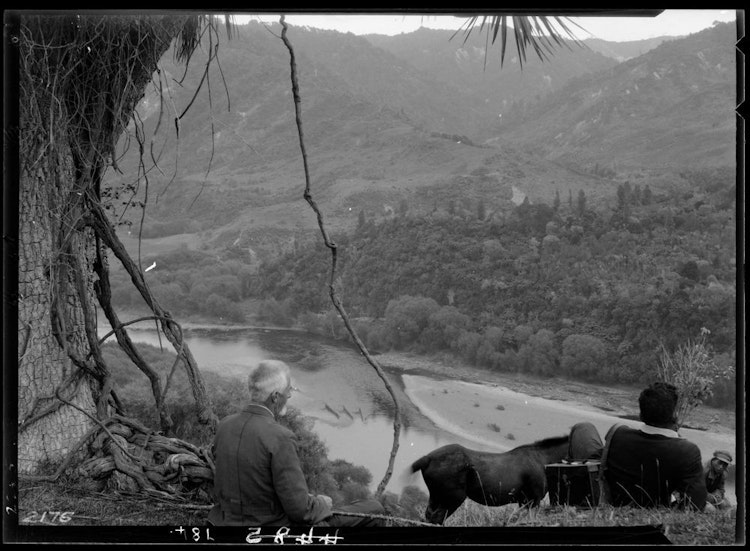
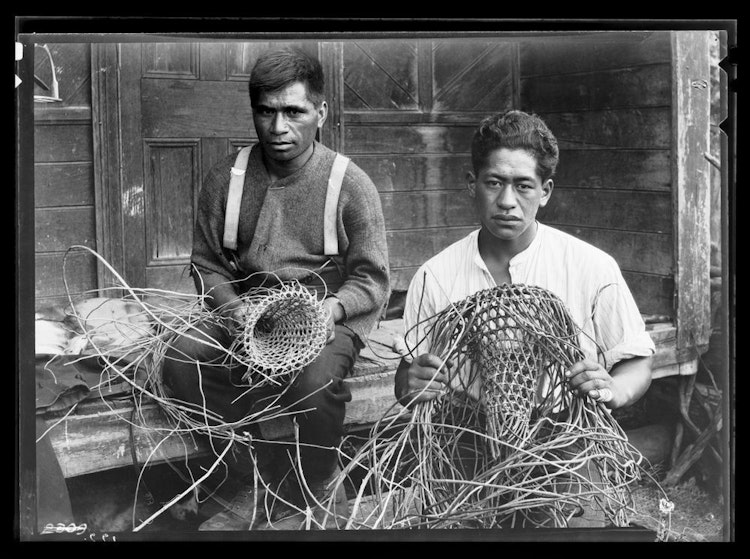
Pa Tuna or Eel Weir, 1921, by James McDonald. Museum of New Zealand Te Papa Tongarewa
Making hinaki nets, 1920, by James McDonald. Museum of New Zealand Te Papa Tongarewa
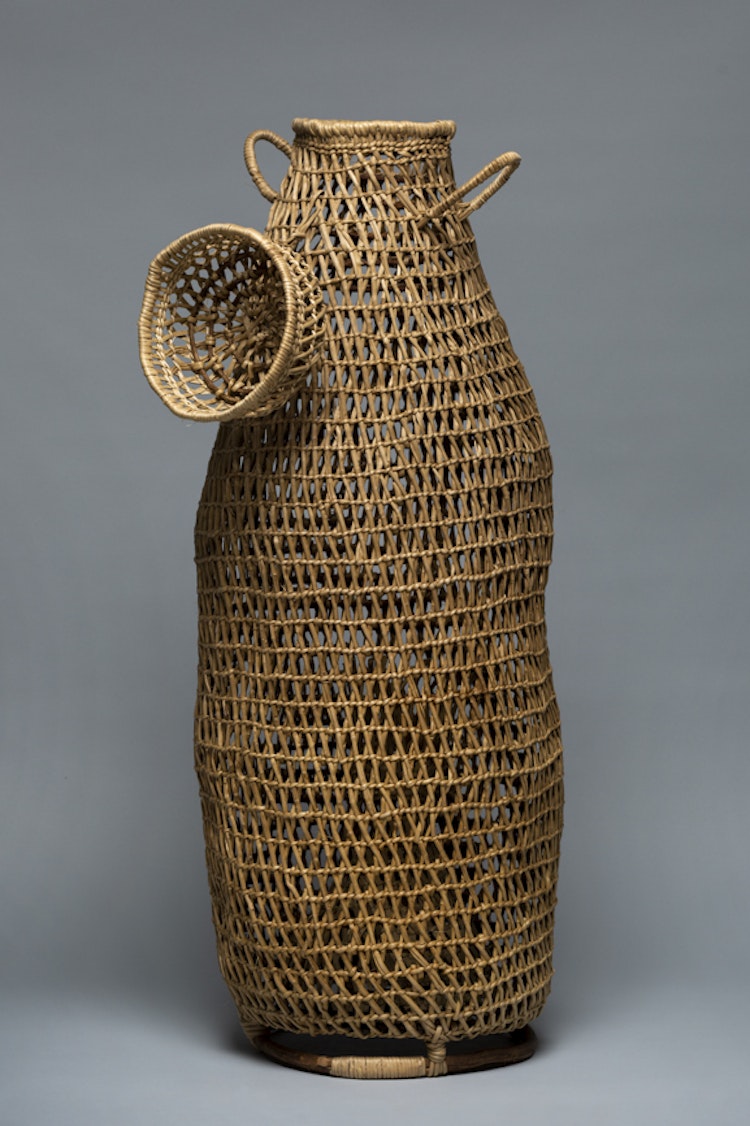
Isaac Te Awa: Your journey into the weaving of hīnaki has been a long one, so let’s start at the beginning. Can you tell us about your first hīnaki and where you learned to make it?
Matthew McIntyre-Wilson: I originally started researching and weaving hīnaki seriously around 2005. Initially the first ones I made were woven from copper, which was a material I was working with in my early jewellery practice. I was also unfamiliar with kiekie at the time. At the time, I had begun to visit museum collections, and one of the things that always stood out was the amount of taonga and objects labelled as “maker unknown”. This included these large and complex hīnaki, and the knowledge they carried. They have been physically disconnected from people, and at the time the identity of the skilled makers who created them was never collected. I knew I wanted to recreate hīnaki and bring focus back to these makers, but I didn’t know anyone who was teaching at the time. This meant I had to teach myself, and I did this by studying those old ones left in museums. To this day, “maker unknown” remains the most important maker in my research.
Isaac Te Awa: Most people familiar with your work know you as a contemporary artist who has blended Māori weaving with fine jewellery. How did you transition from the use of copper back to the materials and techniques used historically on the Whanganui River?
Matthew McIntyre-Wilson: In 2020, I completed the four-month artist residency at the Tylee Cottage. This was based in Whanganui, and I saw this as an opportunity to learn how to make the old style of hīnaki from the people on the river. I went to Whanganui with the goal of learning to make hīnaki, and I was expecting to find people there with the knowledge of making, but as soon as I arrived the local people were asking me, “Oh wow. Can you teach us how to make them?” I knew then that this wasn’t going to be an easy job, but I also wanted to help.
I asked them to give me a couple of months so I could try to make one, and then we could talk about a larger teaching project. Part of the issue with weaving the old style of hīnaki is the material they’re made of. In Whanganui, hīnaki are woven with the aerial roots of the kiekie, a thick vine with long leaves that is native to New Zealand.4
I knew kiekie was used to construct them based on research I had done in Te Papa’s collection stores, but also from reading historic accounts and records. There was also some other wooden vine that was used to provide the internal structure. I didn’t know what this was at the time, and it was meeting and speaking with locals that pieced it all together before I wove my first customary hīnaki.
The people along the Whanganui River are active fishermen. Fishing is deeply tied to the identity of the people and it's part of who they are, but the materials used in the process of fishing have changed with colonisation, the landscape, and availability of resources. They still make hīnaki, but it’s with modern materials like chicken wire and steel.
Photos, courtesy of Museum of New Zealand Te Papa Tongarewa
Isaac Te Awa: The engagement with local Māori who lived along the river was crucial in your research. Can you tell us about the Whanganui people, and how they made the process of recreating hīnaki possible?
Matthew McIntyre-Wilson: The people along the Whanganui River are active fishermen. Fishing is deeply tied to the identity of the people and it's part of who they are, but the materials used in the process of fishing have changed with colonisation, the landscape, and availability of resources. They still make hīnaki, but it’s with modern materials like chicken wire and steel. While the materials have changed, the knowledge and the technology is still the same.
Mana whenua, the local people and their memories were invaluable. While I was in Whanganui, I met a local man, Maehe Ranginui. I went and stayed with him and his whānau who still live on their pā. While I was with them, I spent time with a hīnaki that Maehe’s koro wove. I was able to study it closely and go over and over it. They (the mana whenua) were also able to tell me that the mystery wooden vine used on the inside structure was the native rātā, a tree that starts its life cycle as a vine. When Maehe was 17 (he’s 37 now), the same koro sent him to collect kiekie from a big tōtara tree in the swamp. He took me there; we looked for the tree, which is now gone, but as soon as you got into the swamp there was kiekie growing everywhere. It might not seem like much, but kiekie is particular to its environment. It needs the right conditions to force it to grow long roots that attach it to the ground. The environment that it needs is usually old forest within swamps, and most of that has been cleared over time for farms. This place Maehe showed me is where I gathered the kiekie for the hīnaki I wove, but it’s only one example of what the local people carry in their memories that’s helped me on my journey.
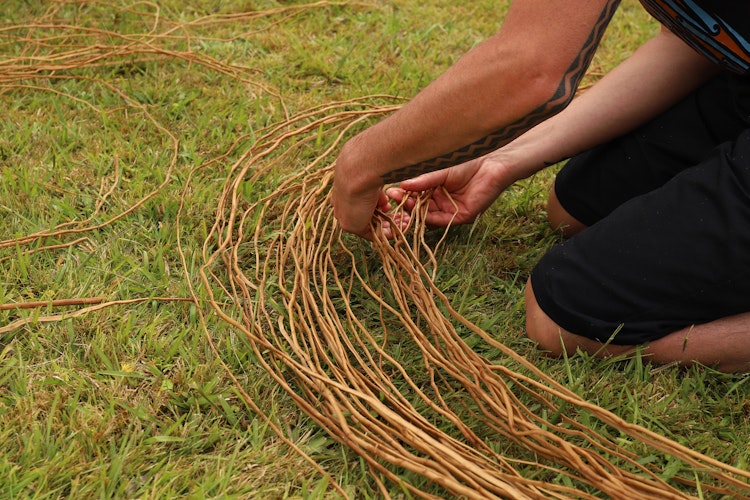
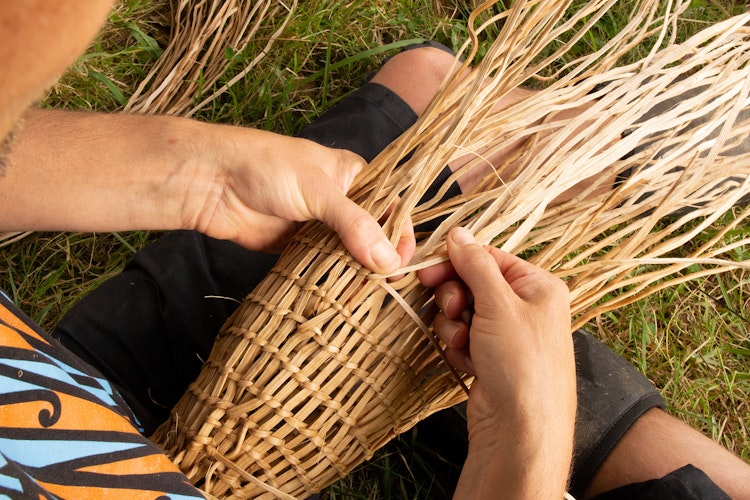
courtesy of the artist
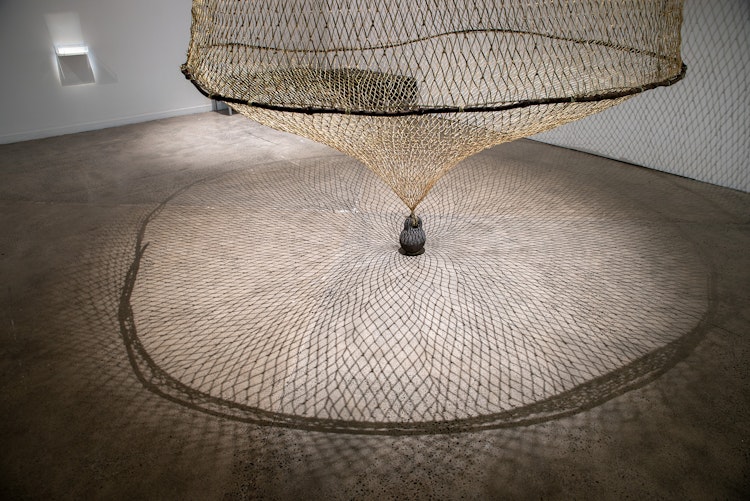
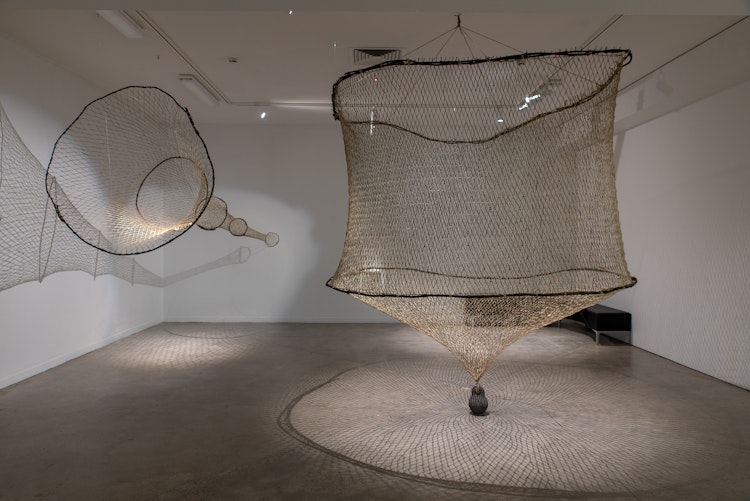
Isaac Te Awa: Hīnaki are complex structures of weaving. Even though you now had the right materials, what else did you have to uncover in order to recreate the process?
Matthew McIntyre-Wilson: Knowing what to do and how to treat the materials is an important part of the process. The kiekie has an outer layer that has to be stripped off before splitting, so that it can be woven. This is a physical skill that hasn’t been passed down, but I read about it in one of Elsdon Best’s books. He mentions a split piece of kareao vine in which the kiekie root is pulled through and stripped of the outer layer. Local people also confirmed that kareao was used. This breadcrumb of knowledge is what tied the academic record to the real practice. From this, I was able to recreate the right tool and a more comfortable process. It took me two days to prepare the roots in this way.
In addition to stripping and splitting, I learnt that the roots also need to be treated. This is done by soaking the roots in a hīnau bark tea, which I did for two weeks. This adds a tannin, which helps the finished hīnaki last longer. From here the actual weaving of the hīnaki took around two weeks. It wasn’t easy. I wanted to undo everything, to try again because I was learning, but I also wanted to get it right. It took time and patience, but in the end it paid off. From gathering to completion took around eight weeks.
The James McDonald and Elsdon Best expedition in 1921 also helped me with this process. They went up the river 100 years ago looking for the same information I was looking for. The film footage and photography captured is held in Te Papa and Ngā Taonga Sound and Vision archives in Wellington, which I was able to access. I had read in books how I was supposed to hold my hands to weave certain techniques, but seeing it in the footage was the definitive factor that made me comfortable with the descriptions. It all clicked and became clear in a way that other photos of the era haven’t quite captured. I think this is because photographs are often posed and don’t capture the actual practical making. More than anything, it’s been the power of observation that informs the process of my weaving, and that’s what made the McDonald footage so valuable.
Isaac Te Awa: Now that you have recreated and learned to make hīnaki in the old way, what is next for you?
Matthew McIntyre-Wilson: Since completing my first
hīnaki last year, I have been working with the people along the river on
a two-year project to teach and restore the craft of hīnaki weaving.
I’m working directly with the different hapū groups along the river, but
it’s also more than just teaching. It’s about mending the decline in
knowledge that has been caused by colonisation and deforestation and, in
return, deepening the connection of people to the river. The knowledge
of making in the old way, the memory of gathering resources, is still
there with the people, like the old hīnaki in the museums which are
still there. It’s just the muscle memory of making that’s asleep, and we
are working together to wake these memories and restore wellbeing to
the people and the Whanganui River.
Isaac Te Awa is Curator Mātauranga Māori at Te Papa Tongarewa Museum of
New Zealand and a colleague of co-editor Cameron Woolford. Images used
from Te Papa's collection in this articles are courtesy of the museum.


